Security forces open fire as Iranians protest in huge numbers on symbolic 40th day since death of 22-year-old
Borzou Daragahi
International Correspondent
Thousands flock to hometown of Mahsa Amini to commemorate 40 days since her death
Tens of thousands of Iranians across the country defied phalanxes of security forces to march and protest against the clerical regime on Wednesday, the religiously potent and politically symbolic 40th day since the death of Mahsa Amini while in the custody of the morality police.
In the central Iranian city of Shiraz, at least 15 people were killed in unclear circumstances after gunmen attacked a shrine, according to state media. Two alleged “terrorists” were arrested and another was being pursued, according to other reports.
The weeks-long movement born of Amini’s death is rooted in opposition to Islamic social rules and led by mostly secular Iranians, and among observers and activists, there were doubts as to whether they would take to the 40th day mourning tradition rooted in faith
But opponents to the regime embraced the day enthusiastically.
Mostly Iranian Kurds living in or near Amini’s western Iranian hometown of Saqez in western Iran could be seen walking for miles along highways and across fields to get to her burial spot after regime forces shut down or restricted vehicular traffic and menaced residents with gunfire since Tuesday night.
Video showed a massive crowd gathered in front of the governor’s office in Saqez.
“Don’t be afraid, don’t be afraid, we are all together,” they chanted.
Protests broke out on university campuses across the country, including in Tehran, the capital, Mashhad, Tabriz, Hamadan, and at high schools among teenagers walking home from classes.
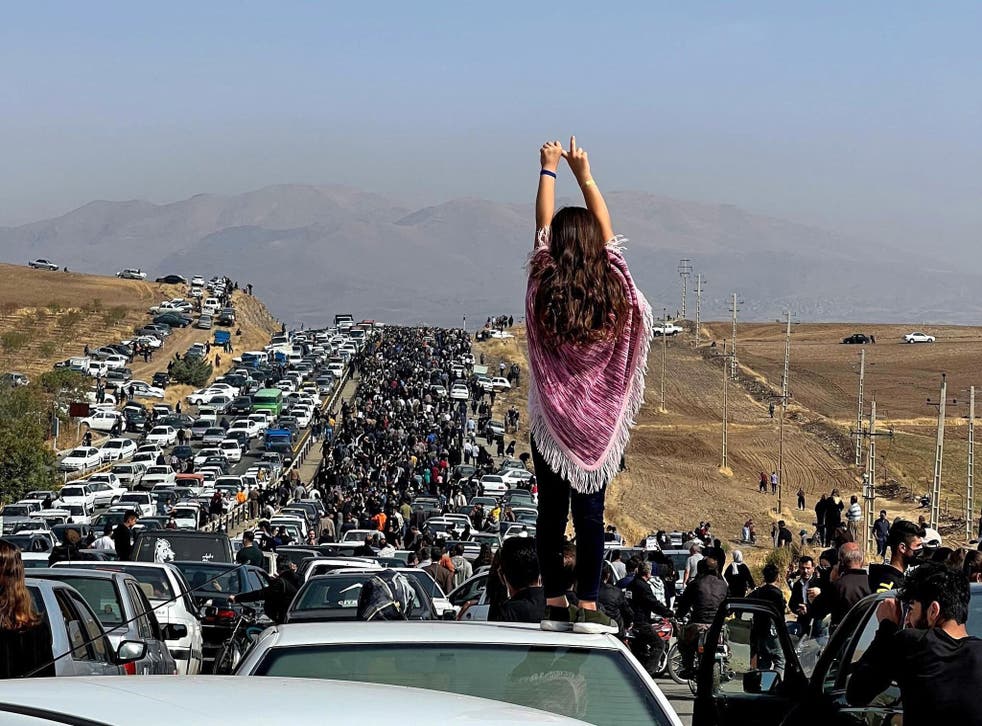
A woman standing on top of a vehicle as thousands make their way towards Aichi cemetery in Saqez, Mahsa Amini’s hometown in the western Iranian province of Kurdistan, to mark 40 days since her death
(UGC/AFP via Getty Images)
“Basijis get lost! Basijis get lost!” women at al-Zahra University could be seen chanting, referring to the Basij paramilitaries terrorising Iranian protesters, as they confronted officials trying to bar their movement.
Doctors and dentists, marking Amini’s passing and as well as voicing anger over a detained fellow medical professional, poured into streets of Tehran, before they were chased away by regime enforcers firing teargas or shotgun rounds, according to video posted online. A shopping mall on central Tehran’s Vali Asr Square was flooded with young protesters, as was the traditional Grand Bazaar that was once the seat of commercial power.
“Freedom, freedom, freedom!” they chanted, according to a video posted online.
Even in the computer bazaar of Tehran, filled with Iranian yuppies who listen to western music and download the latest apps, tech workers in black beat their chests in a mourning ritual.
“We will kill, we will kill, he who killed our sister,” they chanted.
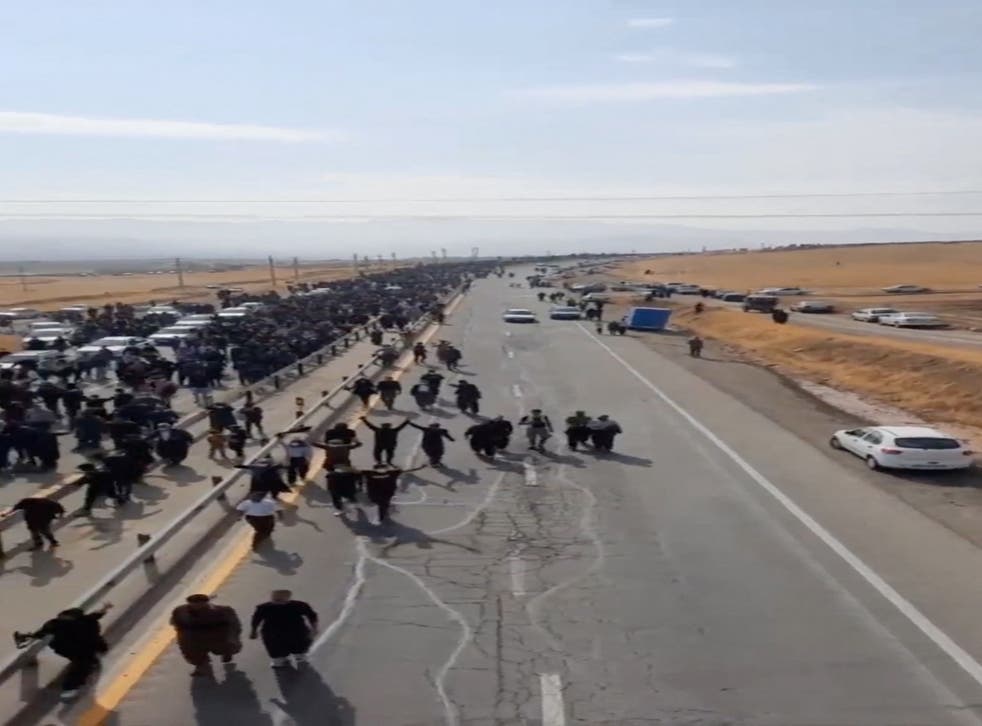
People march down the highway toward the Aychi Cemetery
(VIDEO OBTAINED BY REUTERS)
The country was also hit by labour actions. Workers at a refinery in Tehran went on strike, as did shopkeepers in commercial districts in many cities, including Tehran, Shiraz and Arak. Workers at the Tabriz stock exchange also staged a work stoppage, ostensibly to protest the state of capital markets.
In the Islamic and Eastern Orthodox Christian faiths, the 40th day after a death marks the deceased’s soul passing from the earth to the afterlife. It is often marked by friends and relatives returning to the gravesite to pay their respects.
In the run-up to the 1979 revolution that led to the establishment of Tehran’s clerical regime, 40th day commemorations of dead protesters were marked by political demonstrations met by gunfire and deaths, and further protests 40 days later, in cycles that built up momentum that led to the downfall of the country’s monarchy.
Analysts predict more unrest in the coming days as protesters also mark the 40th days of Nika Shakarami and Sarina Esmailzadeh, two juvenile protesters allegedly killed by regime enforcers.
“The 40th commemoration is tradition more than religion,” said Iranian activist Sharare Mahboudi, who left Iran three years ago after coming under the scrutiny of the security forces. “From now on, Iranians will look for any excuse to protest, even if that protest is religious. And if they beat their chests in mourning and wear black, maybe the security forces will go a little easier on them.”
State broadcast media mostly ignored Wednesday’s protests even as dramatic footage of mass unrest flooded the internet and opposition satellite television channels. The front page of the website of Iran’s English-language Press TV featured stories about protests over the cost of living in France and Spain, but not a word about the unrest at home.
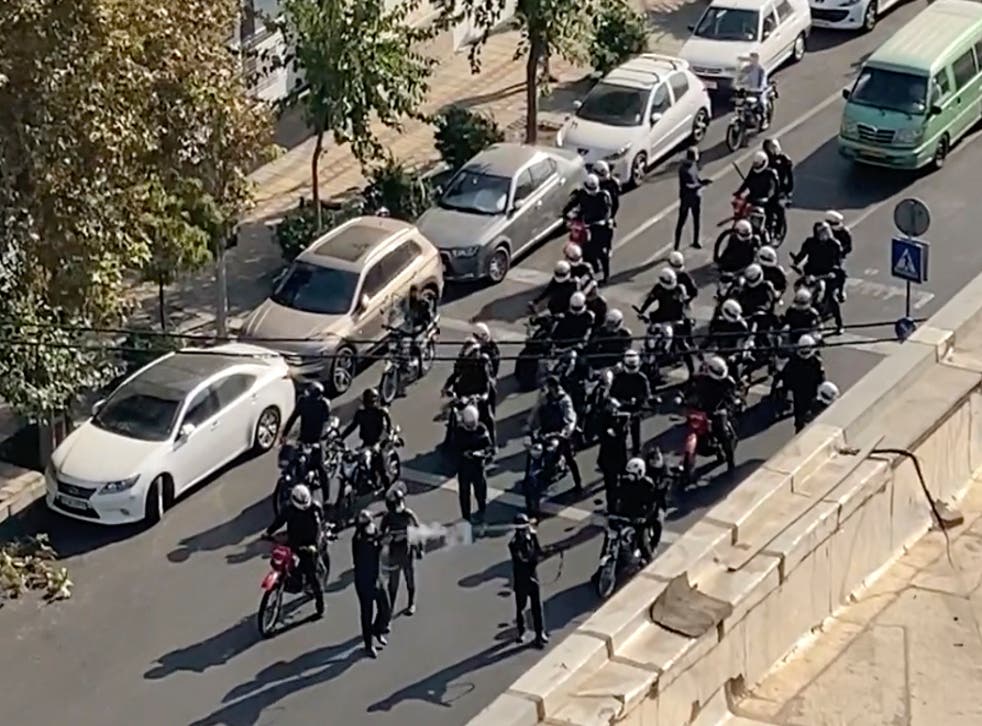
Iranian police arrive to disperse a protest in Tehran
(AP)
The regime has responded to the protests with calibrated violence. At least 252 protesters, including 36 juveniles, have been killed in the violence, and at least 13,533 arrested, according to Hrana, a human rights monitoring group.
The regime blames outside agitators for provoking the unrest, and has vowed to take legal action against UK-based “hostile media" for supporting terrorism. In particular, it has blamed the popular Saudi-backed Iran International television network as well as BBC Persian, as well as Manoto TV, all based in London.
“The UK and the whole empire of lies based in London are sowing chaos and staging psychological warfare” to keep the protests going, said an editorial in the Javan newspaper, which is linked to the Revolutionary Guard.
As dusk settled, trash bins in central Tehran began burning, and streets of some quarters began turning into rock battles between security forces and citizens.
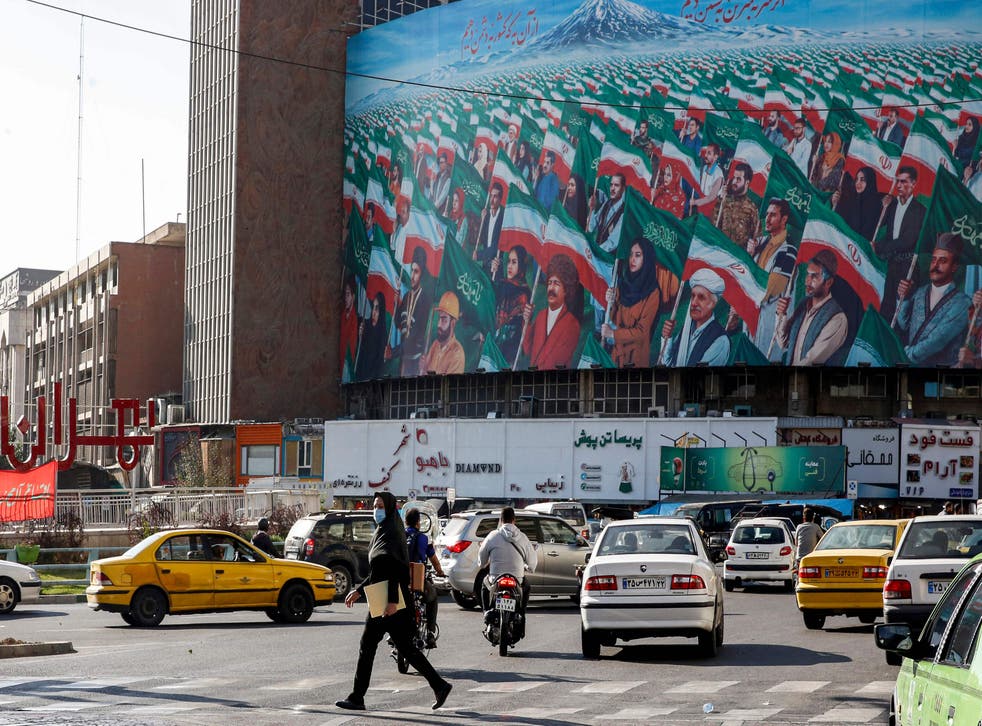
People walk across a pedestrian crossing in Vali Asr square in the centre of Tehran
(AFP via Getty Images)
“This is a revolution,” said Ms Mahboudi, who is regularly in touch with protesters in Iran, including teens who defy their parents’ wishes and take to the streets daily. “Maybe it will take one or two years. Probably a lot of people will die. The regime will kill anybody. They are merciless. And they have nowhere else on the planet to go.”
Wednesday, 26 October, 2022 -

A member of the Iranian community living in Türkiye attends a protest in support of Iranian women and against the death of Mahsa Amini, near the Iranian consulate in Istanbul, Türkiye, October 24, 2022. (Reuters)
Asharq Al-Awsat
Hundreds of protesters poured into the streets of a northwestern Iranian city on Wednesday to mark the watershed 40 days since the death in custody of 22-year-old Mahsa Amini, whose tragedy sparked Iran's biggest anti-government movement in over a decade.
In Amini's Kurdish hometown of Saqez, the birthplace of the nationwide unrest now roiling Iran, crowds snaked through the local cemetery and thronged her grave.
"Death to the dictator!" protesters cried.
State-run media announced that schools and universities in Iran's northwestern region would close, purportedly to curb "the spread of influenza."
In downtown Tehran, shops were shuttered and riot police were out in force. A group of schoolgirls marched through the streets, shouting against the government as cars stuck in traffic honked their support, witnesses said. Anti-government chants also echoed from the University of Tehran campus.
Amini, detained for allegedly violating the country’s strict dress code for women, remains the potent symbol of protests that have posed one of the most serious challenges to the regime.
With the slogan #WomanLifeFreedom, the demonstrations first focused on women's rights and the state-mandated hijab, or headscarf for women. But they quickly evolved into calls to oust the clerics that have ruled Iran since the 1979 revolution.
The protests have also galvanized university students, labor unions, prisoners and ethnic minorities like the Kurds along Iran's border with Iraq.
Since the protests erupted, security forces have fired live ammunition and tear gas to disperse demonstrations, killing over 200 people, according to rights groups.
Untold numbers have been arrested, with estimates in the thousands. Iranian judicial officials announced this week they would bring over 600 people to trial over their role in the protests, including 315 in Tehran, 201 in the neighboring Alborz province and 105 in the southwestern province of Khuzestan.
Tehran prosecutor Ali Salehi told the state-run IRNA news agency that four protesters were charged with "war against God," which is punishable by death in Iran.
Iranian officials have blamed the protests on foreign interference, without offering evidence.
Tensions in Iraqi Kurdistan are high, following several missile and drone attacks in the region from the Iranian Revolutionary Guard.
They were the worst attacks on their closest neighbours for a decade, and were tied to the ongoing protests inside Iran.
The BBC's Nafiseh Kohnavard has been to the highly sensitive border area, and sends this report.
Video by Daisy Walsh, Gabriel Chaim and Lina Issa
Mahsa Amini: Protesters take to Iran’s streets 40 days after her death
Oct 26, 2022
Channel 4 News
Across Iran hundreds of thousands of people have taken to the streets to mark the 40th day of mourning for Mahsa Amini, the young woman who died in police custody after being arrested for not covering her hair completely. In some places those protests have been met with force. The largest gathering was some 600 kilometres from Tehran, in Mahsa Amini's hometown of Saqez in the Kurdish region of Iran.
Al Jazeera English
It has been 40 days since the death of 22-year-old Mahsa Amini. The 22-year-old was arrested in Tehran by Iran’s so-called “morality police” for allegedly not wearing a hijab. She later died in police custody. Her death sparked protests in Iran and around the world. Tehran has imposed internet restrictions and arrested many for taking part in the demonstrations. Al Jazeera's @Dorsa Jabbari reports from Tehran, Iran.
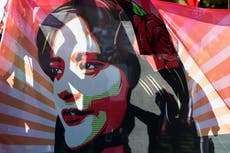
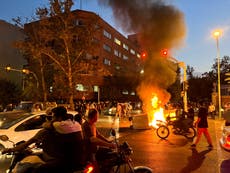
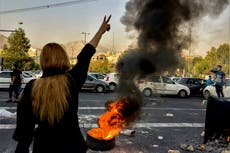
No comments:
Post a Comment